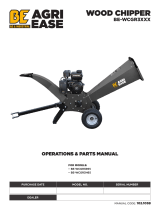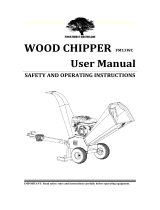
OPERATION
• Never place your hands, feet, or any part of your body in the chipper chute, discharge opening, or near or
under any moving part while the engine is running. Keep clear of the discharge opening at all times. If it
becomes necessary to push material into the chipper chute, use a small diameter stick, NOT YOUR HANDS.
• Keep your face and body back from chipper chute to avoid accidental bounce back of any material.
• The machine should only be operated on a level surface. Never operate your unit on a slippery, wet, muddy, or
icy surface.
• Stay alert for hidden hazards or traffic. Do not carry passengers.
• If the cutting mechanism strikes a foreign object or if your machine should start making an unusual noise or
vibration, immediately stop the engine, remove the spark plug wire(s) and wait for all moving parts to come to a
complete stop. After the machine has come to a complete stop proceed as follows:
• Inspect for any damage.
• Repair or replace any damaged parts before restarting and operating the machine.
• Exercise caution to avoid slipping or falling.
• If the machine should start to vibrate abnormally, immediately stop the engine, remove the spark plug wire(s)
and wait for all moving parts to come to a complete stop and inspect for the cause. Vibration is generally a
warning sign of trouble.
• Stop the engine when leaving the operating position, and when making any repairs, adjustments and
inspections.
• Take all possible precautions as recommended by the manufacturer when leaving the machine unattended.
Stop the engine and remove the key if so equipped.
• Before cleaning, repairing, or inspecting, shut off the engine and make certain the flywheel and all moving parts
have come to a complete stop. Disconnect the spark plug wire and keep the wire away from spark plug to
prevent accidental starting. Do not use flammable solutions to clean air filter.
• Never run this machine in an enclosed area as the exhaust from the engine contains carbon monoxide, which
is an odorless, tasteless, and deadly poisonous gas.
• Keep all guards and safety devices in place and operating properly. Do not operate the machine if all safety
guards are not in place.
• Do not use the unit with the chipper hopper removed.
• The muffler and engine become hot and can cause a severe burn. Do not touch.
• Keep children and pets away.
• Tragic accidents can occur if the operator is not alert to the presence of small children.
• Keep children out of the work area and under the watchful eye of a responsible adult
other than the operator.
• Be alert and turn the unit off if a child enters the area.
• Never allow children to operate the chipper.
• Do not overload or attempt to chip material beyond manufacturers recommendation. Personal injury or
damage to the machine could result.
• Never operate the machine at high transport speeds or on hard or slippery surfaces.
• Never allow bystanders near the unit while running.
• Only use accessories approved for this machine by the manufacturer. Read, understand, and follow all the
instructions provided with the approved accessory.
• Only operate unit in good daylight. Do not operate unit at night or in dark areas where your vision may be
impaired.
• Use extreme caution when reversing or pulling the machine towards you.
• Do not tamper with the engine’s governor setting. The governor controls the maximum safe operation speed
and protects the engine. Over-speeding the engine is dangerous and will cause damage to the engine and to
the other moving parts of the machine. See your authorized dealer for engine governor adjustments.
• Start the engine according to the manufacturers instructions. Keep hands and feet away from inlet and
discharge areas.
• Never pick up or carry the machine while the engine is running.
• Do not operate while under the use of alcohol, drugs, or medication. A clear mind is essential for safety.
• Do not allow anyone who is not alert to operate this machine.
• When feeding material into this equipment, be extremely careful that pieces of metal, rocks, or other foreign
objects are not included. Personal injury or damage to the machine could result.
• Keep area of discharge clear of people, animals, buildings, glass or anything else that will obstruct clear
discharge, cause injury or damage. Wind can also change discharge direction, so be aware.
7





















